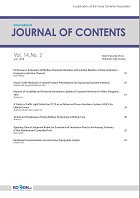- Log In/Sign Up
- P-ISSN1738-6764
- E-ISSN2093-7504
- KCI
 ISSN : 1738-6764
ISSN : 1738-6764
Vol.2 No.4
Abstract
The goal of Ambient Intelligence (AmI) is to build a smart environment for users where they are supported in some of their activities by many interaction mechanisms. The diversity of AmI characteristics requires special support from Operating Systems (OSes). In this paper, in order to support a conscious choice of an operating system for any specific AmI application, features requested by AmI systems were characterized and defined considering various applications. Then, characteristics of existing Operating Systems have been investigated in the context of AmI application support to relate their key characteristics to the typical requirements of AmI systems. Qualitative mapping table between AmI characteristics and as features has been proposed with an illustration of how to use it. As no as completely covers the range of characteristics required by AmI systems, challenging issues are summarized for the development of a new as and a product line of OSes.
Abstract
This paper describes several loop partitioning techniques such as loop splitting method by thresholds and Polychronopoulos' loop splitting method for exploiting parallelism from single loop which already developed. We propose improved loop splitting method for maximizing parallelism of single loops with non-constant dependence distances. By using the distance for the source of the first dependence, and by our defined theorems, we present generalized and optimal algorithms for single loops with non-uniform dependences. The algorithms generalize how to transform general single loops into parallel loops.
Abstract
The number of wireless public network user is increasing rapidly. Security problem for user authentication has been increased on existing wireless network such as IEEE802.11 based Wireless LAN. As a solution, IEEE802.1x (EAP-MD5, EAP-TLS, EAP-TTLS), X.509, protocol or security system was suggested as a new disposal plan on this problem. In this study, we overview main problem on existing EAP-MD5 authentication mechanism on Wireless LAN and propose a SMS(Short Message Service) based secure authentication and accounting mechanism for providing security enhanced wireless network transactions.
Abstract
In this paper, the performance of pre-equalization technique which can be applicable for the B-WLL uplink is evaluated and compared to post-equalization technique under three kinds of rain attenuation channels such as rain, intermittent light rain and thundershower. The BER performance comparisons of two algorithms (LMS and RLS) are investigated in the context of channel models and the length of training sequence. From the simulation results, it is shown that the post-equalization outperforms only at quite good channel conditions such as AWGN, while the pre-equalization can guarantee better BER performance at every channel conditions, especially performance gain increases as the severity of channel increases. It is concluded that the pre-equalizer using LMS algorithm is preferable at delay-tolerant situation where the complexity of algorithm is not a strict factor, while one using RLS is suitable for fast burst transmission with a relatively short training sequence.
Abstract
The mutual exclusion (MX) paradigm can be used as a building block in many practical problems such as group communication, atomic commitment and replicated data management where the exclusive use of an object might be useful. The problem has been widely studied in the research community since one reason for this wide interest is that many distributed protocols need a mutual exclusion protocol. However, despite its usefulness, to our knowledge there is no work that has been devoted to this problem in a mobile computing environment. In this paper, we describe a solution to the mutual exclusion problem from mobile computing systems. This solution is based on the token-based mutual exclusion algorithm.
